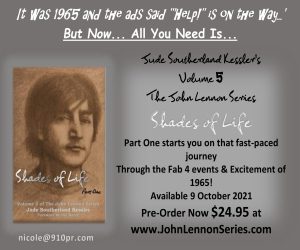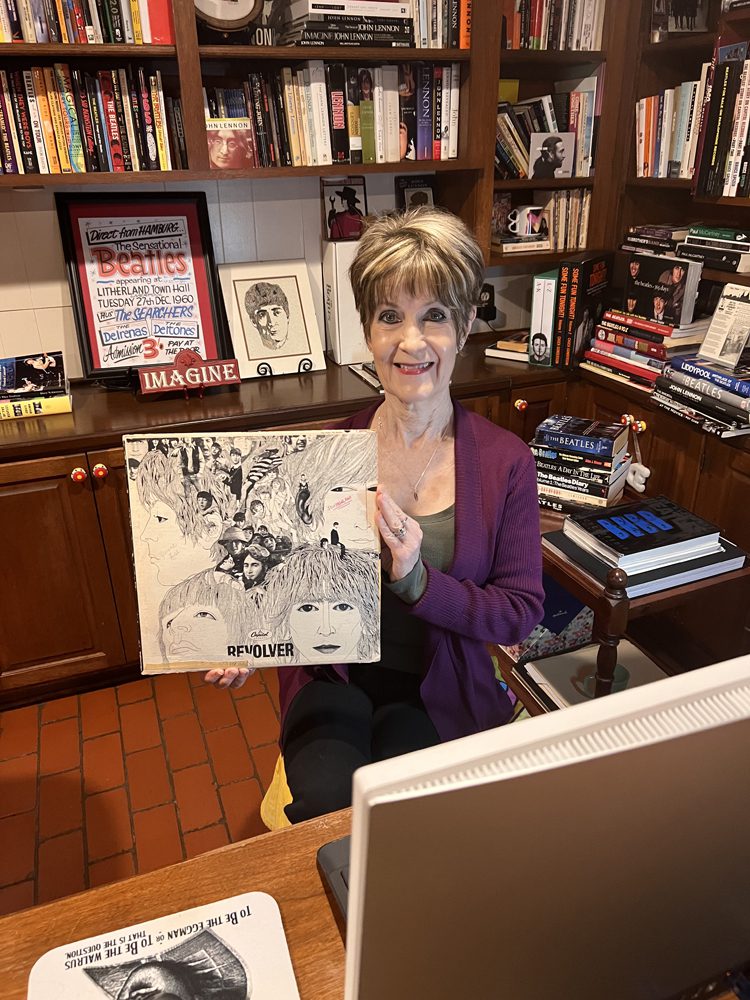by Jude Southerland Kessler
http://www.johnlennonseries.com
It was 1966 … a late summer afternoon in my Cane River home in Natchitoches, LA. The Beatles’ LP Revolver was playing out in the last clicking grooves when I turned to Emily Moss and sighed, “John Lennon has lost his mind.” She nodded, and we sat in silence.
Trying desperately to find something to enjoy on the new Beatles album, we played it over and over again – Emily and I reluctantly latching on to McCartney’s “For No One” and “Eleanor Rigby,” even though we were dyed-in-the-wool “John girls.” But honestly, this album had left us feeling abandoned. Suddenly, and without warning, John and the rest of the lads were writing songs that had zero correlation to the music they’d been singing to us for years. These current offerings, we thought, were train wrecks.
“She Said She Said,” “Tomorrow Never Knows,” “Taxman” … where had the love songs gone?
“It’s awful,” Emily finally said, despondently. I gulped and nodded. We put Revolver back in its artistic cover, and for the next 40 years, my copy was pretty much left to its own devices.
Then in 2012, I read Robert Rodriguez’s insightful book Revolver: How The Beatles Re-imagined Rock’n’Roll, and at last, I comprehended the significance and artistry of that unique, landmark album. I finally grasped the necessity for Revolver in The Beatles’ career as they struggled for change and growth, desperately yearning to move beyond the “yeah, yeah, yeah’s” into a wider dimension of creativity. Under Rodriguez’s patient tutelage, I finally (almost 4 decades later) understood everything that had happened to The Beatles during the suffocating miasma that was labeled Beatlemania.
With the advent of 1966’s revolutionary Revolver, The Beatles (shaking off the confines of “The Fab Four” image) emerged as greatly improved, enhanced musicians – a band clothed in color where grey suits once had reigned supreme, a group employing exotic, world instruments where once there had been only rock’n’roll guitars, drums, and possibly, the odd harmonica or two. In 1966, The Beatles weren’t just thinking outside the box. They were beating the box all to hell. Pushing and experimenting, they obliterated boundaries and strode boldly into tomorrow.
It must have been terrifying for them…to stop mid-career and shake everything up completely.
You see, from 1962-1965 The Beatles experienced a lifestyle not dissimilar to what we’ve been enduring since 2020. They lived three non-stop years “safely” locked away inside fame’s narrow prison – sequestered in hotel rooms, dressing rooms, armored trucks, trains, planes, and automobiles. They repeated the same things over and over and over – until they were sick to death of touring, performing, interviewing, starring in films, and doing television shows. They dealt with the same people day in and day out. And they grew bone-weary of being at the beck and call of their manager, their producer, their film company, the press, and the public. As George Harrison would famously tell us, “It [was] all too much.”
Therefore, by the end of 1965, John, Paul, George, and Ringo decided that if they wanted to survive, they would have to change. And that didn’t mean just talking about change; they would have to do it. Sick of the old, ready for the new, tired of constant isolation, and overwhelmed with the non-stop work that had gradually replaced their social lives, the boys felt compelled to move in a new direction … to step into 1966 ready to alter, adapt, and change.
It was a bold move. Tweaking the carefully-honed image that had produced hit records, gold albums, and Shea Stadium was risky. The boys knew they would be bucking public opinion. But being brave enough to reinvent themselves and “reimagine rock’n’roll” produced stunning results – results that transformed The Beatles into the most incredible studio band of the Twentieth Century. Their fearless retooling gave us not only Revolver but also Sgt. Pepper’s Lonely Hearts Club Band, the White Album, and the Let it Be project (heralded in the recent “Get Back” documentary.)
In his thought-provoking book Yes, And … noted theologian, Fr. Richard Rohr, wrote:
“You do not think yourself into a new way of living … you live yourself into a new way of thinking.”
And that’s precisely what The Beatles did in 1966.
You know, as we move toward the second anniversary of the 2020 Covid outbreak, this segment of Beatles history really speaks to me. There are so many parallels to the experience of living through a pandemic. We, too, were abruptly cut off from society; we too were forced to repeat the same events over and over … so endlessly that it’s difficult, many times, to even discern what day it is. As my friend says to me so often, “I don’t even know which end is up.”
Looking at the way that The Beatles reacted to this sort of existence, I wonder if 2022 isn’t a Revolver opportunity for us all. I wonder if 2022 might be the moment we decide to begin living creatively again. Maybe now is the time to discover the innovative songs we stored away in Covid-safe guitar cases – to dig out unfinished masterpieces, to live ourselves into a new way of thinking and get back to work. Maybe the time has come to change our ways. Perhaps I should even consider tuning up the ole sitar?


























